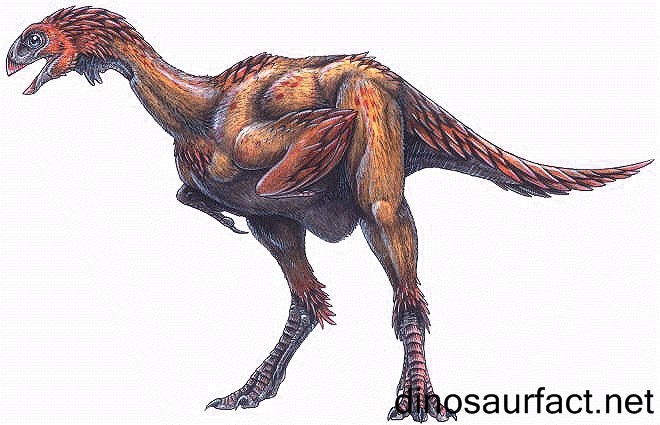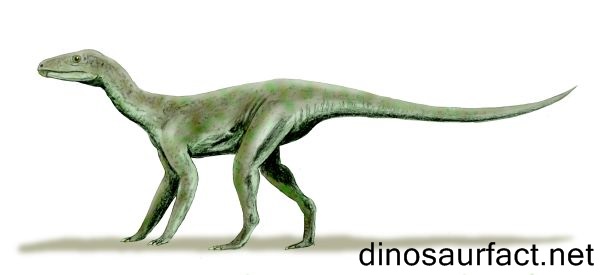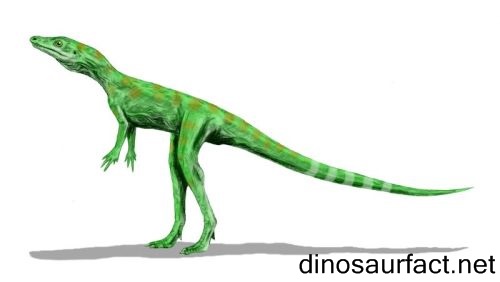 Click to visit the previous dinosaur bio
Click to visit the previous dinosaur bio
 |
|
 |
|
Kingdom: Animalia
Phylum: Chordata
Superorder: Synapsida
Order: Therapsida
Suborder: Sauropsida
Genus: Avipes
 |
|
 |
|
 |
|

The Avipes was an organism that existed in the mid Triassic period. Very little is known about this creature as the fossil evidence establishing its existence is inconclusive to offer any specific details about its size, habits and habitat or nature.
It fossils attributed to the Avipes are believed to be those of an animal belonging to clade Archosauria. Archosaurs are the common ancestors of the present day birds and crocodilians. Some of the species belonging to this clade may have been dinosaurs; or at least relatives of the dinosaurs.
Some paleontologists believe that the Avipes may have been a dinosaur belonging to sub order Theropoda. The fossils ascribed to the Avipes do bear some semblance to Theropods, but it cannot be proven unequivocally that the fossils were indeed those of a Theropod.
The Avipes may have been present on the planet some 245 to 225 million years ago, about the same time most Archosaurs and Theropods existed but this figure is plain speculation.
Etymology
The word ‘Avi’ stands for ‘birds’ in Latin. The suffix ‘pes’ is derived from the Latin word ‘poda’ which translates to ‘feet’. Thus Avipes roughly translates to ‘bird foot’. The suffix ‘-saurus’, which means ‘lizard’ is eschewed from the name of this species as there is no evidence suggesting that the Avipes resembled a lizard. Its physical structure could possibly have differed slightly from dinosaurs and other related species.
Excavation of fossils
The remains of the Avipes were discovered at Bedheim in Sudthuringen, Germany. They were found in sedimentary rocks similar to sandstone. The location of the fossils was in the bottom layer (Lettenkohlensandstein) of the German geological formation called the Erfurt Formation.
Types of bones found in the fossilized remains
Only a few bones of the foot were uncovered in the Erfurt Formation. These included the metatarsal bones. Metatarsal are modified long bones which have a marrow cavity in the center.
Recent investigators have determined that it is not possible to classify these bones into specific genera without more fossils being discovered to compare with.
Erfurt Formation
The Erfurt Formation is a natural rock formation present in Keuper group of Germany. It was named after the town of Erfurt-Melchendorf where it was distinguished by scientist Franz Xaver Hofmann.
The formation is comprised chiefly of sandstone consisting of dolomite, clay stone, evaporites etc. The depth of this structure is about 65 to 80 meters, although this thickness is not uniform all throughout. The stones in the formation are arranged in the form layers.
The color of the structure is predominantly grey and white, but occasional red layers may also be seen. Its lower border is called Lettenkohlensandstein in the north of Germany and Grenz-bones-beds in the southern regions of Germany.
Many prehistoric flora and fauna have been discovered in the Erfurt formation. Along with the Avipes, the remains of the Nanogomphodon, Plagiosuchus, Mastodonsaurus and many more were also unearthed there.
Classification
The Avipes is currently classified under clade Archosauria.
- The fossils were initially considered to belong to clade Ceratosauria or clade Celeosauria. Although there was no consensus on the clade of the fossils, they were unanimously considered to belong to sub order Theropoda. This classification was first suggested by Friedrich von Huene.
- However, the remains were further examined by a group of scientists lead by Hungerbuhler and Rauhut. They determined that the foot fossils were not adequate to specifically classify them. They contested that the remains were not similar to a dinosaur, crocodilian, pterosaur or bird. Therefore, they grouped them as those of a nondescript Archosaur in the year 2000.
Furthermore, no other species related to the Avipes have yet been discovered. The genus Avipes comprises of a single species Avipes dillstedtianus. The fossils discovered in Germany are the sole proofs of the existence of the Avipes.
The species name dillstedtianus is derived from the region of Dillstedt in Germany. The suffix ‘-ianus’ translates to ‘hailing from’ in Latin.
Noteworthy contributors to the classification of the Avipes
Friedrich von Huene and Rauhut and Hungerbuhler were the scientists that studied the remains of the Avipes.
- Friedrich von Huene:
Huene was a prominent paleontologist from Germany. He had worked extensively with dinosaur fossils found across Europe and had helped classify a plethora of remains.
He was born on Tubingen. He had led many excavation operations and had discovered over thirty remains of the Plateosaurus in the Trissingen quarry in Baden-Wurttemberg. Due to his proficiency and command over prehistoric remains, he was assigned the task of trying to classify the remains found in Bedheim.
- Rauhut and Hungerbuhler:
O. W. M. Rauhut and A. Hungerbuhler are contemporary paleontologists. They have worked comprehensively for the classification of many dinosaur remains. The following are few of the species of dinosaurs that the pair has investigated:
- Avipes
- Halticosaurus
- Dolichosuchus
- Pterospondylus
- Velocipes
- Saltopus
Habits
The Avipes is presumed to be a carnivorous being, based on the habits of other Archosaurs. No other information is available about its diet, feeding habits, predators, prey or nesting habits.
Co-existing species
As only a little bit of information is available about the exact time period of the existence of the Avipes, it is difficult to determine species of animals that may have lived alongside it.
Ancestors of present day amphibians, reptiles and birds may have co-existed with the Avipes. Other Archosaurs such as Longosuchus and Saurosuchus along with many Theropod dinosaurs may also have co-existed with the Avipes.
Conclusions
The only information that can be positively considered canon about the Avipes is that it was extant in the middle of the Triassic period. This was determined by carbon dating and other such methods. The only fossils of the Avipes available are a few metatarsal bones. These are nowhere near being adequate to help classify the organism.
There are multiple theories existing about the origins of the Avipes. Some paleontologists consider it to be a theropod dinosaur. Others maintain it is not so. But even those who disagree on its being a dinosaur do not have the answers to its exact classification.
Until further evidence is discovered, the Avipes is only considered to be an indiscriminate Archosaur.
Index
Extinct Profiles
 Triassic Dinosaurs
Triassic Dinosaurs Jurassic Dinosaurs
Jurassic Dinosaurs Cretaceous Dinosaurs
Cretaceous Dinosaurs Pterosaurs
Pterosaurs Marine Reptiles
Marine Reptiles Dinosaur Extinction
Dinosaur Extinction